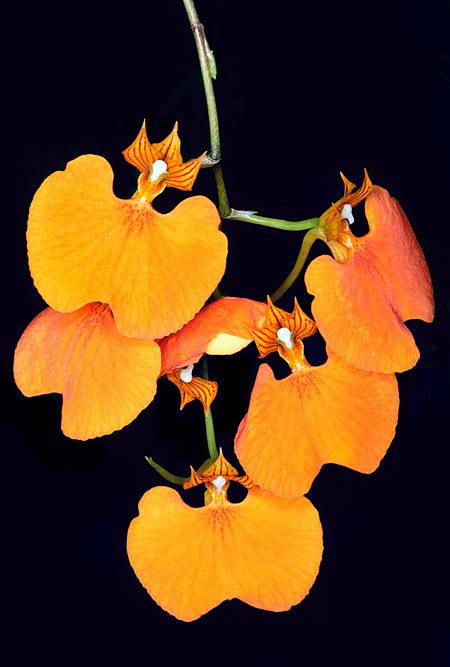Family : Orchidaceae

Text © Pietro Puccio

English translation by Mario Beltramini

Comparettia speciosa inflorescences reach the 50 cm © Giuseppe Mazza
The genus is honoured to the Italian physician and botanist Andrea Comparetti (1745-1801); the name of the species is the Latin term “speciosa” = beautiful, splendid.
The Comparettia speciosa Rchb.f. (1878) is an evergreen herbaceous species with thin creeping rhizome from which originate short pseudobulbs carrying at the apex only one coriaceous leaf, oblong, with pointed apex, 10-25 cm long and about 4 cm broad.
Inflorescence from the base of the pseudobulb, simple or ramified, up to 50 cm long, carrying several flowers grouped in the terminal part of reddish orange colour with red longitudinal striae in particular on a dorsal sepal and petals; like in the Phalaenopsis, by the end of the flowering, from the lowest nodes of the inflorescence may develop new floral stems.
The dorsal sepal is ovate with pointed apex, about 1,5 cm long and 0,5 cm broad; the lateral sepals are united, concave, with at the base a curved and pointed spur, 3,5 cm long. The petals, ovate, with pointed apex, are about 1,2 cm long and 0,5 cm broad and the labellum, trilobate, well spread, is about 2,5 cm long and 3 cm broad; the column is short, about 0,8 cm, greenish, the anther is white. It reproduces by seed, in vitro and by division.
Small orchid, with particularly showy flowers, it requires a shaded position, almost constant temperatures, the lowest ones around the 14-16 °C, the highest ones, 24-28 °C, frequent waterings, but without stagnations on the roots in order to avoid easy rottenness, and high atmospheric humidity, 70-80%; it doesn’t need a precise resting time, only a slight reduction of the waterings in winter; a good air movement is essential.
For the waterings and the nebulisations, are to be utilized either rainwater or water obtained by reverse osmosis or demineralised; the fertilizations, duly distributed and alternated, in way to avoid salts accumulations on the roots, to which it is rather sensitive, are to be done preferably with balanced hydro soluble products, with microelements, at ¼ of the dosage suggested on the package.
It is preferably mounted on bark, raft of cork or of arborescent ferns roots if we are able to maintain a high humidity, otherwise to grow in pots or baskets with much draining, but able to hold the humidity, compost, which can be formed by fragments of bark with sphagnum, agri-perlite and addition of charcoal. The repottings, when necessary, are to be done at the moment of appearance of the new roots.
The species is inscribed into the appendix II of the CITES (species whose trade is internationally ruled).
→ For general notions about ORCHIDACEAE please click here.
